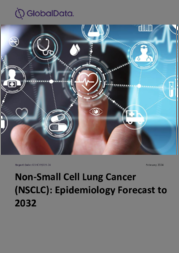
비소세포폐암(NSCLC)은 폐암 중 가장 흔한 유형으로 폐암 전체의 약 85%를 차지합니다. NSCLC는 폐의 내벽을 구성하는 건강한 세포가 변화하고 통제 불능으로 성장하여 종양을 형성하는 것으로 시작됩니다. NSCLC는 폐의 어느 곳에서나 시작되어 비편평상피암 및 편평상피암이라는 다른 조직학적 하위유형으로 분류될 수 있습니다. NSCLC의 정확한 원인은 알려지지 않았지만 폐암의 주요 위험 요인은 흡연입니다. 흡연력이 없는 사람 및 유해한 화학물질에 대한 노출력이 없는 사람의 대부분도 폐암을 발병할 가능성이 있으며, 발병과의 유전적 관련이 시사되고 있습니다.
본 보고서에서는 주요 8개국 시장(미국, 프랑스, 독일, 이탈리아, 스페인, 영국, 일본, 캐나다)에 있어서의 비소세포폐암(NSCLC)의 위험인자, 병존질환, 세계 및 과거의 역학 동향에 대해 개략하고, 크론병의 진단이 끝난 발병 사례 및 진단된 유병률에 관한 10년간의 역학 예측 등을 정리했습니다.
Non-small cell lung cancer (NSCLC) is the most common type of lung cancer, accounting for approximately 85% of all lung cancer cases (National Cancer Institute, 2020). NSCLC begins when healthy cells that make up the lining of the lungs change and grow out of control, forming a tumor. NSCLC can begin anywhere in the lungs and can be categorized into different histological subtypes: non-squamous cell carcinomas (which includes adenocarcinoma, large cell carcinoma, and other types such as undifferentiated or not otherwise specified carcinomas) and squamous cell carcinomas (Cleveland Clinic, 2022). The exact cause of NSCLC is not known, however, the leading risk factor for lung cancer is smoking. Many people with no smoking history or exposure to harmful chemicals can develop lung cancer too, suggesting a genetic link to disease development (Cancer.Net, 2022).
The Non-Small Cell Lung Cancer report provides an overview of the risk factors, comorbidities, and global and historical epidemiological trends for NSCLC in the eight major markets (8MM: US, France, Germany, Italy, Spain, UK, Japan, and urban China). The report includes a 10-year epidemiology forecast for the diagnosed incident cases of NSCLC. The diagnosed incident cases of NSCLC are segmented by age (starting at ages 18-29 years and then in 10-year age groups up to age 80 years and older), sex, stage at diagnosis (stages IA, IB, IIA, IIB, IIIA, IIIB, IIIC, and IV), and histological subtypes: non-squamous cell carcinoma, which includes adenocarcinoma, large cell carcinoma, and others; and squamous cell carcinoma). The diagnosed incident cases of non-squamous cell carcinomas and squamous cell carcinomas are further segmented by genetic mutations. Additionally, this report includes a forecast for the five-year diagnosed prevalent cases of NSCLC. This epidemiology forecast for NSCLC is supported by data obtained from country-specific oncology registries, peer-reviewed articles, and population-based studies. The forecast methodology was kept consistent across the 8MM to allow for a meaningful comparison of the forecast for diagnosed incident cases of NSCLC across these markets.
The Non-Small Cell Lung Cancer Epidemiology series will allow you to -
Develop business strategies by understanding the trends shaping and driving the global NSCLC markets.
Quantify patient populations in the global NSCLC markets to improve product design, pricing, and launch plans.
Organize sales and marketing efforts by identifying the age groups and sex that present the best opportunities for NSCLC therapeutics in each of the markets covered.
Understand magnitude of the NSCLC population by age, sex, stage at diagnosis, histology, immunotherapy biomarkers and genetic mutations.